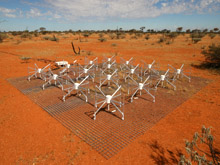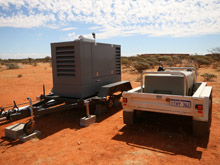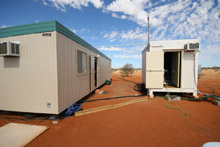Instrument

New generation antenna tile consisting of 16 cross dipoles
The Murchison Widefield Array (MWA) is a revolutionary new low-frequency radio telescope under construction in the outback of Western Australia. It will consist of 512 antenna "tiles", forming a high fidelity imaging array in the 80-300 MHz frequency range. All the hardware for an engineering test bed comprising 32 tiles is currently deployed at site and observations have recently commenced.
MWA characteristics

New 35kVA trailer-mounted, single-phase diesel generator, providing power for the MWA site infrastructure and 32T system.

New MWA lab at Boolardy, Western Australia
The MWA will consist of 8000 dual-polarization dipole antennas optimized for the 80-300 MHz frequency range, arranged as 512 "tiles", each a 4x4 array of dipoles. An illustration of the planned array deployment is shown above together with a photograph of one of the tiles.
The array will have no moving parts, and all telescope functions including pointing will be performed by electronic manipulation of dipole signals, each of which contains information from ~4 steradians of sky centered on the zenith. Each tile will perform an analog beamforming operation, narrowing the field of view to a fully steerable ~25 degrees at 150 MHz. The majority of the tiles (496) will be scattered across a roughly 1.5 km core region, forming an array with very high imaging quality, and a field of view of several hundred square degrees at a resolution of several arcminutes. The remaining 16 tiles will be placed at locations outside the core, yielding baseline distances of about 3 km to allow higher angular resolution for solar burst measurements. FPGA-based massively parallel digital hardware will select and condition a 32 MHz instantaneous bandwidth, and perform cross-correlation and digital array beamforming. Software for array calibration, as well as to support specific scientific goals, will be developed. Summaries of the MWA specifications and technical design are provided in this section. Please use the navigational aids on the left to explore this site further.

